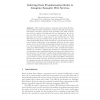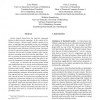156 search results - page 10 / 32 » Verifying Model Transformations by Structural Correspondence |
SEMWEB
2004
Springer
14 years 1 months ago
2004
Springer
Abstract. OWL-S allows selecting, composing and invoking Web Serdifferent levels of abstraction: selection uses high level abstract descriptions, invocation uses low level groundi...
EMSOFT
2010
Springer
13 years 5 months ago
2010
Springer
Constructing correct distributed systems from their high-level models has always been a challenge and often subject to serious errors because of their non-deterministic and non-at...
CG
2007
Springer
13 years 7 months ago
2007
Springer
In this paper, we describe a new optical tracking algorithm for pose estimation of interaction devices in virtual and augmented reality. Given a 3D model of the interaction device...
BMCBI
2005
13 years 7 months ago
2005
Background: The sequencing of the human genome has enabled us to access a comprehensive list of genes (both experimental and predicted) for further analysis. While a majority of t...
SRDS
2006
IEEE
14 years 1 months ago
2006
IEEE
Failure models characterise the expected component failures in fault-tolerant computing. In the context of distributed systems, a failure model usually consists of two parts: a fu...


